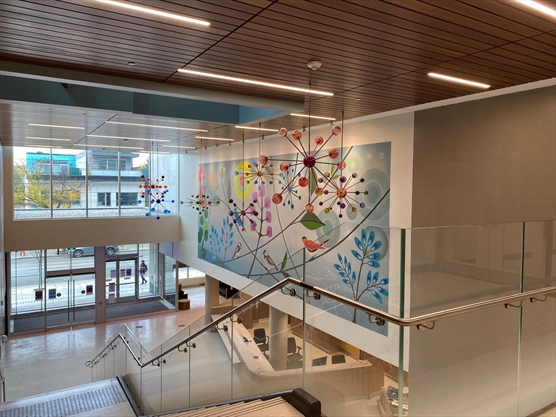Juveria Zaheer eagerly volunteered to work the sleepless overnight shift on the Centre of Addiction and Mental Health’s new emergency department. Other clinicians, she said, requested the same.
“There’s just so much excitement happening,” said Zaheer, a psychiatrist at CAMH.
This excitement is driven by the long-awaited unveiling of two new buildings at Canada’s leading mental health hospital: a new emergency department and a state-of-the-art recovery complex at CAMH’s Queen Street West campus, both featuring central themes of bright, open space and natural light.

The new spaces are part of an ongoing, ambitious redevelopment plan that began in 2006 to integrate CAMH into one campus and build a vision for what the future of mental health care could look like, CAMH’s CEO Catherine Zahn said.
The goal, Zahn said, is for CAMH to move away from an institutional environment by building a bridge with the community that surrounds it, lending to “the acceptance of mental illness, not as something that’s behind walls anymore,” but something that is central to the overall health of the community.
“There’s no health without mental health,” Zahn said.
Over a two-day period starting Wednesday, more than 200 patients were to be transported from the old building on College Street to the new buildings: The Crisis and Critical Care Building, which includes the new emergency department, and the McCain Complex Care and Recovery Building.
It’s a challenging feat due to the pandemic, but one that proved to be timely due to the new buildings’ abundance of space.
“Moving into these new spaces is actually extremely desirable for us during the pandemic,” Zahn said. The new emergency department is double the size of the old one and features more spacious patient rooms, each equipped with a private bathroom, which will limit the sharing of common spaces.
As of Tuesday, CAMH had two patients and seven staff who tested positive for COVID-19, according to the hospital’s website. Zahn said patients will be transported to the new building with the help of moving companies who are following rigorous sanitation procedures to ensure a safe move.
The move includes COVID-19 positive patients, where Toronto Public Health was also consulted.
In addition to more physical space, the Crisis and Critical Care Building features an outdoor terrace for patients to access fresh air, and more rooms for group therapy sessions and other recovery programs. It also offers more space dedicated to triaging patients.
“In our current space, I’ll walk into the (emergency) department and there will be people in rooms, but there will also be people in stretchers and people sitting in seats and sleeping there,” Zaheer said. “Having more rooms will make a world of a difference.”
There are 235 new patient beds in total between the new Critical Care Building and the Complex Care and Recovery Building. This includes an increase of Psychiatric Intensive Care Units from nine to 41 — more than quadrupling the previous capacity of beds that were fully at use by both CAMH and patients from other area hospitals.
Alongside housing patient beds, the McCain Complex Care and Recovery Building will also serve as a unique, transformative hub for patients to learn life skills needed on their path to recovery.
Part of this is a “therapeutic neighbourhood,” which holds a laundry room, an exercise room and an industrial-sized kitchen affiliated with George Brown College, where patients can take classes and learn how to perform daily tasks. The building is also home to music and art studios for various forms of art therapy.
Erin Ledrew, a recreation therapist at CAMH, said the McCain complex was created with the help of existing literature on what mental health care can and should look like, and will serve as “a central programming space” for patients.
“I think that will create a real sense of community,” Ledrew said.
The McCain building also features a library that is open to the public and tied to CAMH’s larger vision of connecting the hospital with its surrounding community. Both buildings also feature artwork from previous CAMH patients, some of whom are Indigenous and channelled their culture and recovery journey into their art.
For now, patients will be engaged in physically distant in-person tours of the new space, while virtual ones will be offered simultaneously. Ledrew said the building is large enough to offer some programming in a safe and distant manner as well.
“Right now, we have a hybrid model that will allow us to still offer all of that programming, while maintaining not mixing (units) and continuing to follow all the protocols during COVID,” Ledrew said.
The hope is that the new buildings will offer better care for patients and their families while providing the space and facilities to guide them in life beyond their time at CAMH, Ledrew said.
“We’re really trying to offer spaces for people to feel safe to explore the strategies that work for them in their recovery,” she said.
Nadine Yousif is a Toronto-based reporter for the Star covering mental health. Her reporting is funded by the Canadian government through its Local Journalism Initiative. Follow her on Twitter:
